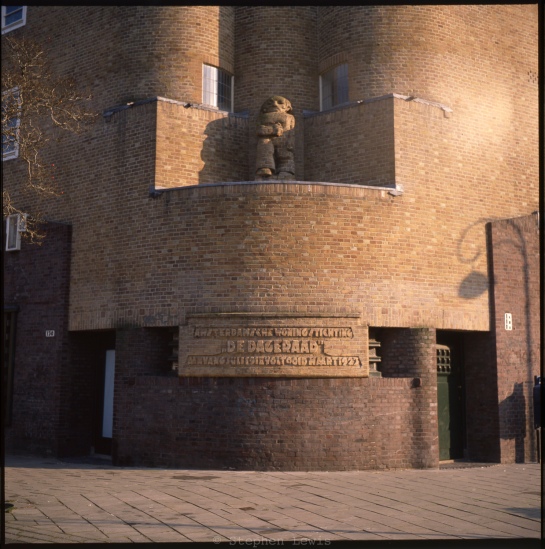Amsterdam-South, Long Ago: Rounded Corners, Garden Gnomes, Dreams and Disappointments
To tourists at least, the city of Amsterdam is best known for its historic urban core of 17th- and 18th-century townhouses set along a grid of concentric and radial, tree-lined canals, and for its supposed openness and tolerance, its red-light district and easy availability of drugs.
Stereotypic legends of the population of Amsterdam’s inner city are no less the stuff of guidebook hyperbole: free-spirited hippies and revolutionaries, rough-and-tumble but lovable Dutch proletarians, sardonic barflies, and Jewish market workers, cigar makers, and diamond-cutters. In reality, however, 90% of Amsterdam’s Jews were murdered during the Second World War; the inner city’s Dutch proletariat out-migrated to suburban new towns during the post-war decades; sardonic barflies yielded way to “cool” cafe-goers; and counter-cultural “Provos” of the 1960s were replaced by heroin addicts, urban “pioneers,” and, ultimately, by well-off gentrifiers.
My own favorite neighborhoods of Amsterdam were far from the historic center and closer to the urban edge. Late in the 19th century, the municipality of Amsterdam began a process of urban renewal and clearance of overcrowded slums. First, new tenement neighborhoods were constructed, modern in terms of the time, and parks and green-spaces were laid out. Then, during the early decades of the twentieth century, housing estates and apartment buildings were built farther afield, many financed and constructed by cooperative movements formed on the basis of political affiliation, labor union membership, and/or religious confession. The signature architectural style of the such cooperative housing was Dutch Expressionism, aka the Amsterdam School, a style that featured rounded corners and curved lines, garden-gnome-like sculptural ornamentation, hints of Jugendstil and Bauhaus, cream-colored brick facades rather than the traditional Dutch dark-red, and windows that were tiny in comparison with those of older townhouses.
The center of Amsterdam embodies nostalgia for a mythologized Dutch “Golden Age” but the apartment buildings and cooperative housing complexes of early-twentieth-century neighborhoods such as Amsterdam-South represent a forward-looking vision and a socio-political dream: a commitment to social and economic equality and the development and perfection of the individual, this animated by a spirit of cooperation, and shaped and nurtured by a built environment designed with that very purpose in mind. I wonder from afar whether today, a century after the development of Amsterdam-South and in the wake of waves of demographic change, decades of post-war prosperity, and the transformation of housing from social infrastructure to commercial commodity, anything of this ethos survives or is even remembered in the streets in which it once flourished.
The Photographs
At the top of the page: the dedicatory inscription at a corner of an apartment block in the early-1920s socialist cooperative housing complex De Dageraad (The Dawn). (For excellent architectural photos of the complex, see the entry for De Dageraad in the Dutch-language Wikipedia.) Below: An early-20th-century municipal sculpture alongside the Amstel river. Both photos taken during the early-1980s on color positive film using a Rolleiflex f3.5 Tessar twin-lens reflex.

